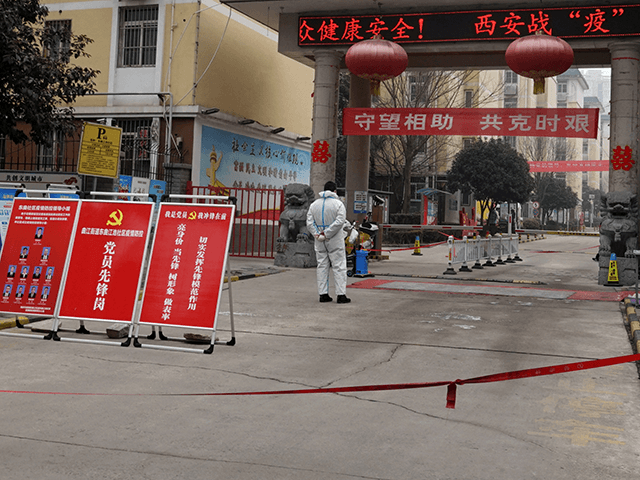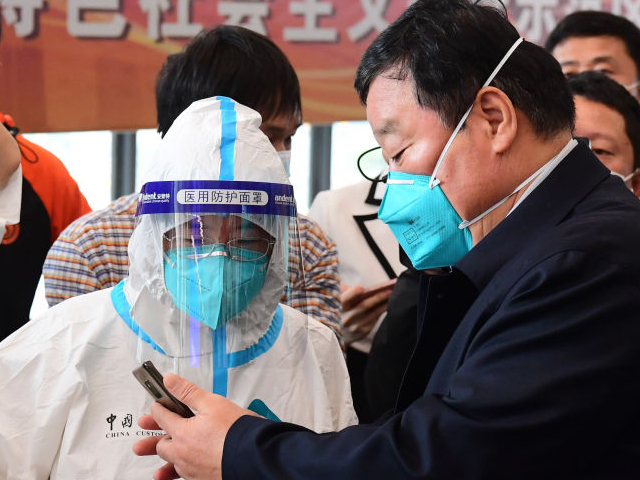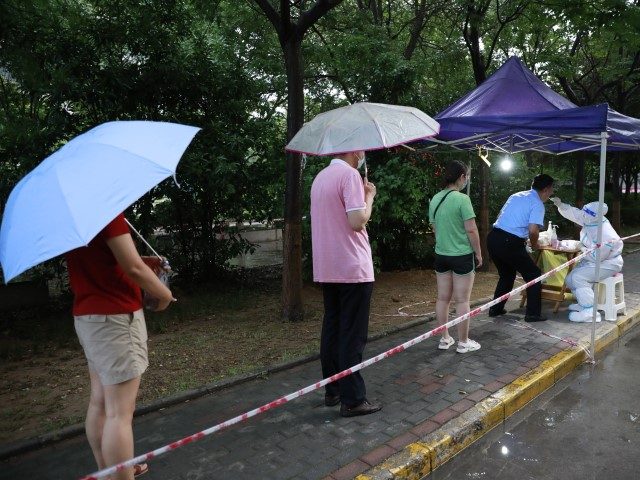The huge city of Xi’an in northwestern China on Tuesday became the latest to impose lockdowns in China’s spreading coronavirus outbreak.
Xi’an announced a seven-day period of “closed-off management” to contain an outbreak at the Zhaohui Renewable Resources Trading Market – a market where surplus energy capacity from wind and solar power is bought and sold under China’s byzantine rules.
Xi’an was put under a severe lockdown from December 2021 through January 2022 after a “Covid cluster” swelled to encompass over 2,100 reported cases, causing some anxiety among Chinese officials ahead of the prestigious Winter Olympics in Beijing.

Flag bearers Tingyu Gao and Dan Zhao of Team China carry their flag during the Opening Ceremony of the Beijing 2022 Winter Olympics at the Beijing National Stadium on February 4, 2022, in Beijing, China. (Lintao Zhang/Getty Images)
The hideous year-end lockdown in Xi’an became a source of public anger across China, as public officials were blamed for bungling the process and leaving citizens without adequate supplies of food and medicine. The Chinese Communist government implemented strict censorship to stifle complaints from the starving captive citizens of Xi’an. When residents began dying from lack of medical care, the national government sacked some Xi’an officials to satisfy the angry public.

A man in a protective suit stands guard at an entrance of a residential compound in Xi’an in China’s northern Shaanxi province on January 5, 2022. (Photo by STR/AFP via Getty Images)
According to the state-run Global Times’s description, “closed-off management” sounds like another lockdown for many of the city’s 13 million residents, although at least they haven’t been made prisoners in their own homes yet:
For seven days starting on Wednesday, July 6, Xi’an will suspend on-site dining at restaurants and all group gatherings, including religious activities. Entertainment, cultural and sports venues will close for a week, including internet cafes, KTVs, bars, chess rooms, cinemas, gyms, libraries and museums.
Kindergartens, primary and middle schools will start the summer vacation ahead of schedule. People with a green health code can work from offices.
“Green health code” refers to the mandatory smartphone app China uses to monitor the coronavirus testing status of citizens. The health code app was recently abused for political purposes, falsely assigning “red” codes and forcing people into quarantine to prevent them from joining protest marches.

A customs officer checks the health QR code of Liang Wannian who leads a team of Chinese mainland medical experts at Shenzhen Bay Port on February 28, 2022 in Shenzhen, Guangdong Province of China. (Chen Wen/China News Service via Getty Images)
As usual with Chinese coronavirus propaganda, the Global Times insisted the number of infections triggering the lockdown was astonishingly low – only 18 cases were detected over the weekend, most of them “waste recycling workers at the Zhaohui market” – and the culprit was an omicron coronavirus subvariant that allegedly “came from outside China, although the source is not clear.”
“We must race against both time and the virus … to guard against all possible risks and hidden dangers, and decisively avoid an explosion in community spreading,” municipal official Zhang Xuedong said at a press conference on Tuesday.
“The Omicron BA.5 subvariant is even more transmissible and spreads more quickly than the previous BA2.2 sublineage, and it is more likely to escape antibodies,” Zhang said.
“It’s like they’re addicted to lockdowns. What else can they even do?” groaned one Xi’an resident on social media when the new measures were imposed.
More such cries of dismay were heard from Shanghai this week, as the once-bustling city that became a lockdown horror story was subjected to a new round of mandatory coronavirus testing. Mass testing is generally the only warning Chinese citizens get before their rulers impose brutal quarantines on them.
Beijing also ordered fresh rounds of mass testing for some districts on Wednesday. The national capital has been partially shut down a few times during the pandemic but has never been subjected to the kind of grueling procedures enforced on Xi’an or Shanghai.

COMMENTS
Please let us know if you're having issues with commenting.